30 km/h cities are the future, but real-time control is difficult: the solution
Can speed cameras or potholes be ways to control the 30 km/h limit in the city? We propose an analysis of this new future of urban mobility and beyond.
30 km/h cities are the future, but real-time control is difficult: the solution
Can speed cameras or potholes be ways to control the 30 km/h limit in the city? We propose an analysis of this new future of urban mobility and beyond.
30 km/h cities: what they are and what are the benefits
The issue of road safety is one that is unfortunately talked about negatively every day.
In 2022, according to Istat, there was a 9.2% increase in road accidents with injuries in Italy compared to 2021. This number is expected to continue to increase in 2023. Indeed, already in the first 9 months of 2023 these increased by 9.4% compared to the same period in 2022.
The most common cause of traffic accidents in Italy is distracted driving, followed by excessive speed and drunk driving.[1]
Too many traffic accidents make it clear how much targeted and effective action is needed to protect motorists and especially cyclists and pedestrians. One good measure is the introduction of a 30 km/h speed limit on all urban roads.
Currently, several European cities have already adopted the 30 zone, including Brussels, Paris and Olbia, which was one of the first Italian cities to implement it. The results are also very promising. For example, in Copenhagen, this measure led to a 77% reduction in accidents and 88% reduction in injuries in 30 Zones in just three years.
The adoption of 30 zones is also fully supported by the European Parliament. Its main goal is to reduce road deaths in urban areas to zero by 2050.[2]
How can the “city 30” model achieve this ambitious goal?
It not only has to do with a speed issue, but opens the door to a new city concept. It involves a more efficient flow of road traffic and a series of structural interventions to upgrade urban public space. In this way, areas are less oriented toward cars and more designed for people.
In addition, to make “City 30” work, it is necessary to promote light mobility, improve public transportation and encourage the use of various means of transportation.
We again find the important role of people. Their participation and communication also enable this change from a cultural point of view. The 30km/h city is not, in fact, a city against motorists. It is necessary for people to understand and share with each other that this model is in favor of a safer and livable urban environment for all.
In conclusion, speed limit changes lead to significant improvements in road safety, improving the quality of urban life.
The 30km/h city model and the problem of potholes: the case of Bologna
Since July 1, 2023, Bologna is officially a “City 30.” As of this day, the maximum speed limit on all urban roads in Bologna changes from 50 to 30 km/h. Only on major thoroughfares, it is fixed at 50km/h.
In detail, 30km/h goes to 70% of the streets in the built-up area and 90% of those in the part of the city most densely lived in by people. [3]
This marks the beginning of a new path to becoming a more sustainable, safe and efficient city.
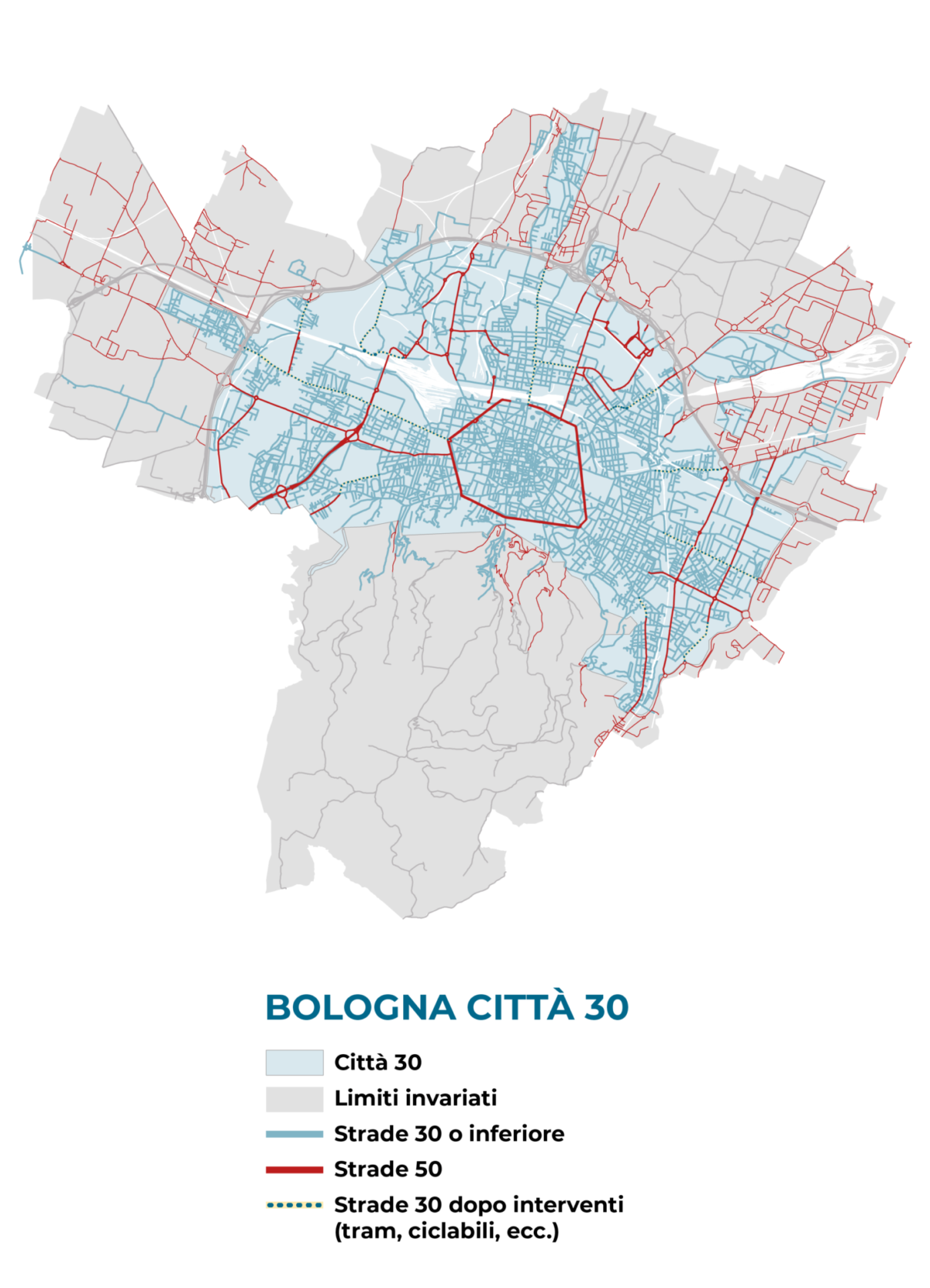
|
Source: Bologna Città 30 |
Bologna will soon be transformed into a more comfortable place with more accessible streets and new green and pedestrian areas. Indeed, in the coming years, street signs will change, new road markings will be put in place and streets will be redesigned.
Thus, this new city model will also solve a major problem highlighted in September 2023 by Maurizio Martelli, director of the Roads, Safety and Bikeways sector of the City of Bologna.
During a major conference, in fact, he spoke about citizen complaints about potholes on the roads. According to him, resurfacing them leads to another problem, namely, these roads become race tracks, where drivers reach 90km/h. His sentence has animated a lot of public debate, but it is very thought-provoking.
Hence the need to find systems to reduce speed, which are not just speed cameras. According to Martelli, there is not so much difference between a speed bump and a pothole, but neither is the right tool to encourage people to adopt a speed appropriate to the safety of the road.
The case of Bologna is emblematic. Although the two events may seem disconnected, together they resolve but leave one issue unresolved. Indeed, with the imposition of the 30 km/h limit, it was thought that the problem of urban safety had been solved. The case of potholes, however, highlights the need for a new system that can allow for vehicle speed control.
The solution to reduce the 30 km/h limit all the time
The penalty system for those who violate these new limits will start on January 1, 2024. On 30 roads, control will be entrusted to the traffic wardens, while fixed speed cameras will be only on 50 roads.
It is difficult for law enforcement officers to stay at all times to keep watch on the road. Moreover, we remember that the speed cameras are only able to detect violations that occur near the detection point.
So how can it be assured that these new speed standards will always be followed on all roads?
At this historic moment of major changes, it is crucial that monitoring is managed in the best way possible to allow all the benefits that this city model brings to be met.
As we all know, artificial intelligence (AI) is having a profound impact in various sectors and changing the way we live. All cities can benefit from this technological revolution and achieve a new balance between efficiency and sustainability.
AI-enabled video sensors can be a valuable and practical support for law enforcement agencies. Let’s find out more.
Such sensors do not just record what they see. They can analyze captured images in real time, identifying suspicious behaviors or situations. In this case, they can help identify the average speed of vehicles on the roads immediately and at all times and send notifications to the officers, who can intervene promptly.
Compared with current speed monitoring systems, smart video sensors allow for broader coverage without the need for police officers to be on site. Artificial intelligence algorithms are more accurate in detecting speed with greater precision.
In addition, IA is more efficient. Police officers have to devote time and resources to check speed, while AI can be used to monitor roads automatically. Finally, compared to speed cameras, they are more functional because they can detect violations anywhere on the road.
Public safety is a priority for any city and Artificial Intelligence offers advanced tools to improve the protection and welfare of citizens.
Beyond that, it is useful for traffic congestion. AI can help predict traffic patterns, suggesting alternative routes in real time and optimizing traffic lights to reduce traffic jams. Based on real-time traffic data, AI could automatically adjust the timing of traffic lights.
These are just a few examples of how Artificial Intelligence could transform mobility and traffic management by reducing congestion and improving transportation efficiency. The city could provide a better living experience for its residents and become more attractive to visitors.
In conclusion, the use of AI and sensors for 30 km/h speed control is a necessary solution to ensure road safety, improve urban livability and make the measure effective. It seems clear that progress to best materialize must come through innovation.
References:
-
-
- Istat. Online version: https://www.istat.it/
- Parlamento Europeo. Online version: https://www.europarl.europa.eu/news/it/press-room/20210930IPR13926/zero-morti-sulle-strade-ue-entro-il-2050
- Bologna città 30. Online version: https://www.bolognacitta30.it/
-
© Copyright 2012 – 2023 | All Rights Reserved
Author: Rossana Cascione, Digital Marketing Specialist
30 km/h cities: what they are and what are the benefits
The issue of road safety is one that is unfortunately talked about negatively every day.
In 2022, according to Istat, there was a 9.2% increase in road accidents with injuries in Italy compared to 2021. This number is expected to continue to increase in 2023. Indeed, already in the first 9 months of 2023 these increased by 9.4% compared to the same period in 2022.
The most common cause of traffic accidents in Italy is distracted driving, followed by excessive speed and drunk driving.[1]
Too many traffic accidents make it clear how much targeted and effective action is needed to protect motorists and especially cyclists and pedestrians. One good measure is the introduction of a 30 km/h speed limit on all urban roads.
Currently, several European cities have already adopted the 30 zone, including Brussels, Paris and Olbia, which was one of the first Italian cities to implement it. The results are also very promising. For example, in Copenhagen, this measure led to a 77% reduction in accidents and 88% reduction in injuries in 30 Zones in just three years.
The adoption of 30 zones is also fully supported by the European Parliament. Its main goal is to reduce road deaths in urban areas to zero by 2050.[2]
How can the “city 30” model achieve this ambitious goal?
It not only has to do with a speed issue, but opens the door to a new city concept. It involves a more efficient flow of road traffic and a series of structural interventions to upgrade urban public space. In this way, areas are less oriented toward cars and more designed for people.
In addition, to make “City 30” work, it is necessary to promote light mobility, improve public transportation and encourage the use of various means of transportation.
We again find the important role of people. Their participation and communication also enable this change from a cultural point of view. The 30km/h city is not, in fact, a city against motorists. It is necessary for people to understand and share with each other that this model is in favor of a safer and livable urban environment for all.
In conclusion, speed limit changes lead to significant improvements in road safety, improving the quality of urban life.
The 30km/h city model and the problem of potholes: the case of Bologna
Since July 1, 2023, Bologna is officially a “City 30.” As of this day, the maximum speed limit on all urban roads in Bologna changes from 50 to 30 km/h. Only on major thoroughfares, it is fixed at 50km/h.
In detail, 30km/h goes to 70% of the streets in the built-up area and 90% of those in the part of the city most densely lived in by people. [3]
This marks the beginning of a new path to becoming a more sustainable, safe and efficient city.

|
Source: Bologna Città 30 |
Bologna will soon be transformed into a more comfortable place with more accessible streets and new green and pedestrian areas. Indeed, in the coming years, street signs will change, new road markings will be put in place and streets will be redesigned.
Thus, this new city model will also solve a major problem highlighted in September 2023 by Maurizio Martelli, director of the Roads, Safety and Bikeways sector of the City of Bologna.
During a major conference, in fact, he spoke about citizen complaints about potholes on the roads. According to him, resurfacing them leads to another problem, namely, these roads become race tracks, where drivers reach 90km/h. His sentence has animated a lot of public debate, but it is very thought-provoking.
Hence the need to find systems to reduce speed, which are not just speed cameras. According to Martelli, there is not so much difference between a speed bump and a pothole, but neither is the right tool to encourage people to adopt a speed appropriate to the safety of the road.
The case of Bologna is emblematic. Although the two events may seem disconnected, together they resolve but leave one issue unresolved. Indeed, with the imposition of the 30 km/h limit, it was thought that the problem of urban safety had been solved. The case of potholes, however, highlights the need for a new system that can allow for vehicle speed control.
The solution to reduce the 30 km/h limit all the time
The penalty system for those who violate these new limits will start on January 1, 2024. On 30 roads, control will be entrusted to the traffic wardens, while fixed speed cameras will be only on 50 roads.
It is difficult for law enforcement officers to stay at all times to keep watch on the road. Moreover, we remember that the speed cameras are only able to detect violations that occur near the detection point.
So how can it be assured that these new speed standards will always be followed on all roads?
At this historic moment of major changes, it is crucial that monitoring is managed in the best way possible to allow all the benefits that this city model brings to be met.
As we all know, artificial intelligence (AI) is having a profound impact in various sectors and changing the way we live. All cities can benefit from this technological revolution and achieve a new balance between efficiency and sustainability.
AI-enabled video sensors can be a valuable and practical support for law enforcement agencies. Let’s find out more.
Such sensors do not just record what they see. They can analyze captured images in real time, identifying suspicious behaviors or situations. In this case, they can help identify the average speed of vehicles on the roads immediately and at all times and send notifications to the officers, who can intervene promptly.
Compared with current speed monitoring systems, smart video sensors allow for broader coverage without the need for police officers to be on site. Artificial intelligence algorithms are more accurate in detecting speed with greater precision.
In addition, IA is more efficient. Police officers have to devote time and resources to check speed, while AI can be used to monitor roads automatically. Finally, compared to speed cameras, they are more functional because they can detect violations anywhere on the road.
Public safety is a priority for any city and Artificial Intelligence offers advanced tools to improve the protection and welfare of citizens.
Beyond that, it is useful for traffic congestion. AI can help predict traffic patterns, suggesting alternative routes in real time and optimizing traffic lights to reduce traffic jams. Based on real-time traffic data, AI could automatically adjust the timing of traffic lights.
These are just a few examples of how Artificial Intelligence could transform mobility and traffic management by reducing congestion and improving transportation efficiency. The city could provide a better living experience for its residents and become more attractive to visitors.
In conclusion, the use of AI and sensors for 30 km/h speed control is a necessary solution to ensure road safety, improve urban livability and make the measure effective. It seems clear that progress to best materialize must come through innovation.
References:
-
-
- Istat. Online version: https://www.istat.it/
- Parlamento Europeo. Online version: https://www.europarl.europa.eu/news/it/press-room/20210930IPR13926/zero-morti-sulle-strade-ue-entro-il-2050
- Bologna città 30. Online version: https://www.bolognacitta30.it/
-
© Copyright 2012 – 2023 | All Rights Reserved
Author: Rossana Cascione, Digital Marketing Specialist

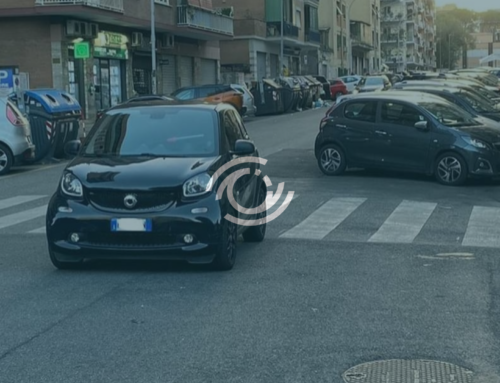


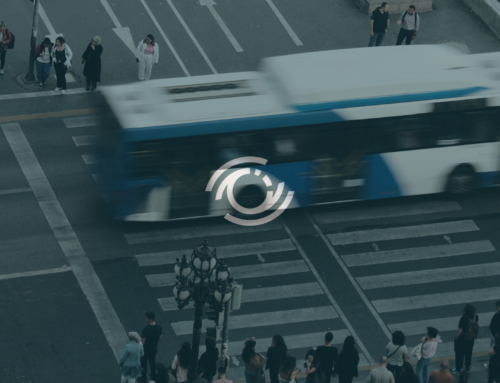

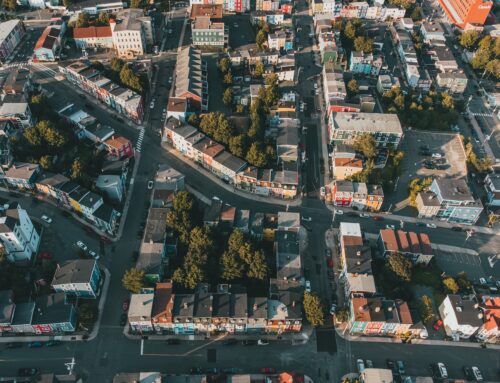





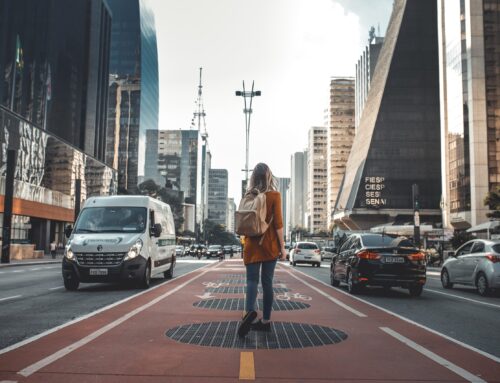
Very interesting subject, appreciate it for posting.Raise blog range